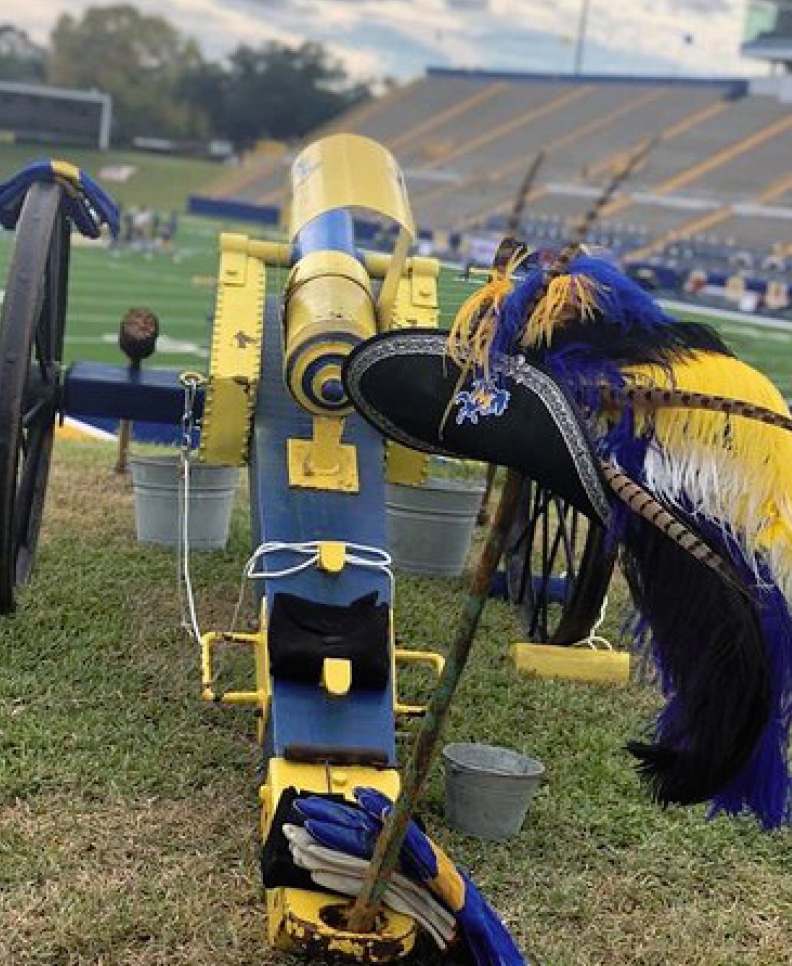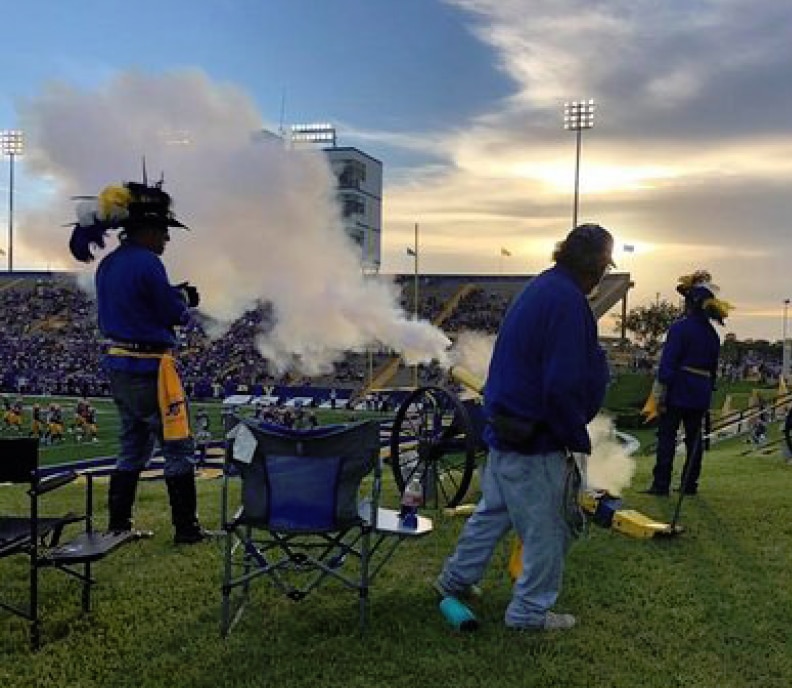Lake Charles Buccaneers Keep MSU’s Cannons Firing
By Brad Goins
Faithful fans of McNeese football know that each time the Cowboys score, they are saluted by a blast from a cannon.

Since the Cowboys cannon is a real military cannon, it has to be used, maintained, cleaned and fired just as any military cannon is. Too much water, dirt or oil in the cannon, and the results could be highly undesirable.
In the past, cannon-firing duties at McNeese were handled by the ROTC — the Reserve Officers Training Corp. When the ROTC left McNeese, Harry Clark, a member of the Lake Charles Buccaneers, took over the cannon firing job in 1998.

As Clark grew older, it came time for a change of command. Buccaneer member Mark Laverne basically took over the cannon firing process in 2013.
Laverne was trained in cannon firing by the U.S. Cavalry. Instructors of the Cavalry also train people in Civil War battle re-enactment groups who fire cannons. Laverne had also taken instruction at the Safety Council of Southwest Louisiana.
Although Laverne is retired now, he worked at Citgo for 35 years. While there, he was on the emergency response team. He credits his work experience at Citgo for preparing him to do the work required by the rules and protocol of firing cannons in public. With his experience, he can do such tasks as preparing sign-up sheets, conducting training and dealing with the paperwork involved with safety inspections as well as the work involved with making any changes an inspector may require.
Early on, the group that handled the cannons sometimes had difficulties with students who wanted to act out around the cannons. Also, at the time, the cannons were firing toward the end zone, which means they were firing toward the players there. Although it was probably perfectly safe, there was always the nagging fear of a freak accident.
After renovation of the goal line area, the team was given a new 50-feet wide area that placed them well out of the range of the players and audience.
How Does It All Work?
The Buccaneer team gathers on the field for an operational meeting long before the game begins. The 
There’s a test firing of the cannons at 2 pm on the day of the game. The crews call that “clearing the cannon’s throat.” The obvious objective is to make sure there’s no unnecessary dirt, debris or moisture in the barrel. After the barrel is cool enough, crews do the oiling of the cannon that is necessary to keep it in functioning order.
Before a cannon is fired in a game, crew members make a “shell” by wrapping aluminum foil around the third of a pound of gunfire. After the blast, the crew must make sure all remnants of the aluminum foil are removed from the barrel as soon as possible.
The crews must use water to keep the cannon barrels cool. After each blast, barrels are swabbed down as long as necessary. Afterwards, crew members must remove any water that’s gotten inside the barrel. If there’s too much water, it could get the primer wet, which would prevent an explosion.
Timing Is Crucial

When a touchdown was scored, the crowd immediately burst into applause; the announcer described the play; the band played “Jolie Blon” and the cannon fired. Laverne was especially concerned that the cannon’s roar might drown out the announcer; he felt it was important for the announcer “to give people credit.”
Laverne also learned it was important not to fire the cannon the instant the referee put up his hands. If something happened in the next few seconds, and the play was called back, it was awkward to have gone ahead and fired the commemoratory cannon shot. Now, the cannon is only fired when it’s certain the touchdown will stand.
Special Effects
Of course, the McNeese cannons don’t fire any kind of missile — not even one made of aluminum foil. It’s “just noise and fire,” says Mark Laverne. The cannon will shoot out a jet of fire that may be as long as 20 feet. Laverne says the 90-decibel blast produces “that southern boom that kind of makes everybody happy.”
The cannon can also, at times, produce special effects. “If the wind is right,” Laverne says, a giant smoke ring will blow across the McNeese field.
He says that last season, a smoke ring “went right through the goal post as they kicked a field goal.” Laverne says that after the game, people asked him, “How did you do that?” But of course, he did nothing out of the ordinary. He thinks the curious phenomenon was mainly the result of wind speed and direction and the degree of moisture in the cannon’s barrel.
Cannons Convey MSU Information
Laverne and the other Buccaneers don’t just fire the cannon when McNeese scores. They fire when the team takes the field; they fire when the first and the last of the Para Pokes parachute team lands on the football field. If the Cowboys win the game, a cannon is fired when the clock ticks down to zero. (If they lose, no cannon is fired.) After the game, the Cowboys team members gather to sing along with the band’s performance of the school’s Alma Mater. When the song is over, the cannon is fired one last time.
Laverne thinks that McNeese is the only team in the conference that fires a real cannon during games.
Although the cannon blasts are mainly for the amusement of the fans in the bleachers, they also serve to alert people outside the stadium that something has happened. Laverne says that some people who are deeply involved in tailgating will opt to stay where they are rather than attend the game. The sound of the cannon blast lets them know they’d better focus on their radio broadcast to find out what’s happened.
Laverne served as Jean Lafitte in 2017. He leads charitable “raids” for all sorts of local groups. And he aims to keep the cannons firing at McNeese regardless of how much time and work that effort requires.
















Comments are closed.